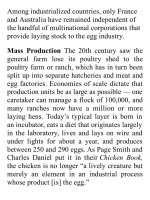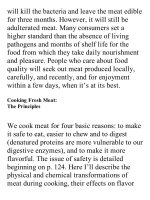On food and cooking the science and lore of the kitchen ( PDFDrive ) 413
Bạn đang xem bản rút gọn của tài liệu. Xem và tải ngay bản đầy đủ của tài liệu tại đây (122.91 KB, 2 trang )
box,p.212)arebesteithercookedquicklyto
an enzyme-killing but somewhat drying
160ºF/70ºC, or else cooked to a lower
temperatureandservedimmediately.
PreparationsforCooking
CleaningandCuttingMostfishinU.S.
marketsaresoldprecleanedandprecut.This
iscertainlyconvenient,butitalsomeansthat
thescaledandcutsurfaceshavebeenexposed
totheairandbacteriaforhoursordays,
dryingoutanddevelopingoff-flavors.
Preparingfishatthelastminutecangive
fresherresults.Bothwholefishandpieces
shouldberinsedthoroughlyincoldwaterto
removefragmentsofinnerorgans,the
accumulationofodorousTMA,otherbacterial
by-products,andbacteriathemselves.
Presalting Japanese cooks briefly presalt
most fish and shrimp to remove surface
moisture and odor and firm the outer layers.
This is especially useful for getting fish skin
to crisp and brown quickly when fried.As is
trueformeats,presoakingfishandshellfishin
a 3–5% salt brine will cause the flesh to
absorbbothwaterandsalt,withmoisturizing
andtenderizingresults(p.155).
TechniquesforCookingFishandShellfish
Themanymethodsforheatingmeatsandfish
aredescribedindetailinthepreviouschapter,
pp.156–65.Briefly,“dry”heatingmethods—
grilling,frying,baking—producesurface
temperatureshighenoughtoproducethe
colorsandflavorsofthebrowningreactions,
while“moist”techniques—steaming,
poaching—failtotriggerbrowning,butheat
foodsmorerapidlyandcansupplyflavors
fromotheringredients.(Chinesecooksoften
getthebestofbothmethodsbyfirstfryinga
fishandthenfinishingitwithabriefbraisein









